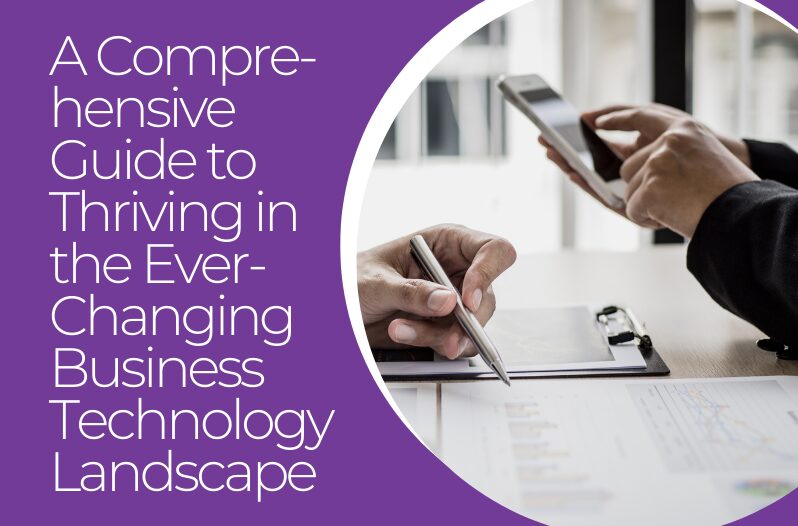In an era of unprecedented technological advancement, businesses face the constant challenge of adapting to stay competitive. This guide offers a deep dive into navigating the turbulent waters of tech evolution, providing actionable strategies to not just survive, but thrive amidst rapid change.
The Technological Revolution: Understanding the Drivers of Change
1.1 Artificial Intelligence (AI)
AI is revolutionising business operations through machine learning, natural language processing, and computer vision. These technologies are being applied across various industries, yielding impressive results. However, the adoption of AI also raises important ethical considerations, necessitating a responsible approach to implementation.
1.2 Big Data and Analytics
The realm of big data is characterised by the 5 V’s: Volume, Velocity, Variety, Veracity, and Value. Modern businesses are leveraging real-time analytics and predictive modelling to gain actionable insights. However, with great power comes great responsibility, and organisations must prioritise data governance and privacy considerations.
1.3 Cloud Computing
Cloud services come in various forms, including Infrastructure as a Service (IaaS), Platform as a Service (PaaS), and Software as a Service (SaaS). Many businesses are adopting hybrid and multi-cloud strategies to optimise their operations. The rise of edge computing is also reshaping how businesses process and utilise data.
1.4 Blockchain and Distributed Ledger Technologies
Blockchain’s potential extends far beyond cryptocurrencies, with applications in smart contracts and decentralised applications. Various industries are exploring specific use cases for blockchain. However, adoption comes with its own set of challenges and limitations that businesses must navigate.
1.5 Internet of Things (IoT)
The IoT ecosystem encompasses devices, connectivity, data processing, and applications. Industrial IoT is transforming manufacturing and supply chains. However, the proliferation of connected devices also brings significant security and privacy challenges that must be addressed.
Strategies for Embracing Technological Change
2.1 Cultivating an Innovation-Driven Culture
To foster innovation, businesses should implement robust innovation management systems. Encouraging intrapreneurship and idea generation can unlock creativity within the organisation. Creating cross-functional innovation teams can break down silos and accelerate technological adoption.
2.2 Comprehensive Skill Development
A skills gap analysis framework can help identify areas for improvement. Organisations should create personalised learning paths for employees to ensure relevant skill development. Leveraging micro-learning and just-in-time training methodologies can make learning more accessible and effective.
2.3 Strategic Technology Partnerships
When evaluating potential technology partners, businesses should have clear criteria and follow best practices. Co-innovation and collaborative R&D initiatives can accelerate technological advancement. It’s crucial to manage intellectual property effectively in these partnerships.
2.4 Agile and DevOps Integration
Scaling agile methodologies across the organisation can increase adaptability. Implementing continuous integration and continuous deployment (CI/CD) can speed up software development and deployment. The challenge lies in balancing agility with necessary governance and compliance measures.
2.5 Robust Cybersecurity Framework
Adopting a zero-trust security model can enhance overall security posture. Implementing AI-driven threat detection and response can provide more robust protection. Regular security audits and penetration testing are essential to identify and address vulnerabilities.
Change Management in the Digital Era
3.1 Digital Transformation Strategy
Aligning technology initiatives with business objectives is crucial for successful digital transformation. Creating a digital roadmap helps prioritise initiatives effectively. Managing resistance to change and fostering buy-in are key challenges in this process.
3.2 Data-Driven Decision Making
Implementing data literacy programs can empower employees to leverage data effectively. Creating a single source of truth for organisational data ensures consistency. Leveraging predictive analytics for strategic planning can provide a competitive edge.
3.3 Customer-Centric Innovation
Using design thinking for problem-solving can lead to more innovative solutions. Implementing voice of customer (VoC) programs ensures that innovations address real customer needs. Creating digital customer experience platforms can enhance customer satisfaction and loyalty.
Measuring and Sustaining Technological Change
4.1 Comprehensive KPI Framework
A balanced approach to KPIs should include both leading and lagging indicators. Industry-specific KPIs for technology adoption can provide more relevant insights. Creating dashboards for real-time performance monitoring enables quick decision-making.
4.2 Continuous Feedback and Improvement
Implementing agile retrospectives across the organisation can drive continuous improvement. Leveraging AI for sentiment analysis and feedback processing can provide deeper insights. Creating a knowledge management system for lessons learned ensures that insights are not lost.
4.3 Scaling and Optimising Tech Initiatives
Developing a centre of excellence for emerging technologies can accelerate adoption. Creating playbooks for technology adoption and scaling ensures consistent implementation. Implementing portfolio management for tech initiatives helps prioritise and optimise investments.
Future-Proofing Your Business
5.1 Horizon Scanning and Trend Analysis
Utilising AI for technology trend prediction can provide early insights into emerging technologies. Participating in industry consortiums and standards bodies keeps organisations at the forefront of technological developments. Creating an emerging technology assessment framework helps evaluate new technologies systematically.
5.2 Building Adaptive Capabilities
Developing scenario planning and war-gaming exercises prepares organisations for various future scenarios. Creating modular and flexible IT architectures enables quicker adaptation to technological changes. Fostering a growth mindset across the organisation creates a culture ready to embrace change.
Conclusion:
Navigating tech turmoil is no longer optional—it’s a critical component of business strategy. By understanding the drivers of change, implementing robust strategies for technology adoption, and creating a culture of continuous learning and adaptation, businesses can turn technological disruption into a powerful competitive advantage.
The journey of digital transformation is ongoing, and the most successful organisations will be those that embrace change as a constant, viewing each technological shift as an opportunity for innovation and growth. By following the strategies outlined in this guide, you can position your business at the forefront of the technological revolution, ready to seize the opportunities of tomorrow.
Are you ready to lead your organisation through the tech turmoil and into a future of innovation and growth? Start by assessing your current technological capabilities and creating a roadmap for change. Remember, the future belongs to those who prepare for it today.





